Frequency-Selective Gamma Generators in Processing of Auditory Stimuli
Abstract
Processing of sensory stimuli is controlled by the top-down influences that shape oscillations in the synchrony form revealed in the EEG. However, little is known about the nature of these influences. The present study investigated the contribution of "evoked oscillations" in the perception of auditory stimuli during passive and active attention from the position of pacemaker hypothesis on the origin of gamma rhythm. To analyze the problem, the author suggests a special method based on the narrow frequency filtering event-related potentials, localization of dipole sources of gamma oscillations over the structural MRI slices. Computation of equivalent dipoles for the discrete frequencies demonstrates interaction between prefrontal and auditory cortex during active attention to auditory stimuli. The obtained results are compatible with the pacemaker hypothesis.
Themes: Psychophysiology
Pages: 299-308
DOI: 10.11621/pir.2008.0019
Keywords: psychophysiology, methodology
High-frequency electrical brain activity, gamma rhythm, is associated with intense mental activity and cognitive function in general. It is connected with perception, awareness, response to novelty, voluntary and involuntary attention and memory (Eckhorn et al., 1990; Lutzenberger, W., Pulvermul-ler, F., Birbaumer, N., 1994; Pulvermuller, F., Preissl, H., Lutzenberger, W. and Birbaumer, N., 1995; Singer, 1999; Danilova, 2000; Danilova, Bykova, Anisimov, Pirogov, Sokolov, 2002; Tallon-Baudry, Bertrand, O., Bouchet, P. and Pernier, J. 1995; Tallon-Baudry C, Kreiter A., Bertrand O., 1999).
Inclusion of gamma oscillations into different sensory, cognitive, performing processes, its existence not only in human, but also in animal brain allowed E. Basar (Basar, 1999; Basar-Eroglu, Karakas, Shurman, 2001) to consider gamma-rhythm as functional building blocks used in integration of brain processes and realization of psychical functions.
Under increased interest in gamma oscillations many questions are still to be answered. For example, mechanism of gamma oscillation origin is not clear. There are two basic conceptions about mechanisms of gamma rhythm generation: binding hypothesis and pacemaker hypothesis.
According to the binding hypothesis gamma rhythm is resulted in circulation of impulses within neuronal assembly. Oscillatory activity in the neuronal assemblies appeared by means feedback and reciprocal loops among its neurons. The pacemaker hypothesis suggests existence of pacemaker neurons as intracellular generators of gamma oscillations. Pacemaker neurons are characterized by next properties:
The endogenous rhythmical activity in pacemaker neurons did not disappear after absolute isolation of pacemaker neurons from contacts with others neurons (Grechenko, 1999). The impotent characteristic of pacemaker neuron - its response to input stimuli. Excitatory inputs to these neurons can produce phase shift (reset) of endogenous oscillations phase-locked to input stimuli.
Thus, the assembly hypothesis of gamma rhythm origin assumes presence at least two spatially separate centers of activity and signal transmission from one center to other. According to pacemaker hypothesis such mechanism of signal transmission is not required.
To testing pacemaker hypothesis of gamma oscillations origin we investigated "evoked" gamma rhythm as well compatible with pacemaker neuron properties during the perception of auditory stimuli in the conditions of passive and active attention.
The new experimental approach was developed for this aim - the method of microstructure analysis of gamma rhythm (Danilova, 2000, 2006) that includes:
- Narrow band frequency filtering of event-related potentials (with 1 Hz step) in the gamma range between 30 and 75 Hz.
- Computation of equivalent dipole sources for discrete frequencies in gamma range.
- Combination equivalent dipole analysis with structural MRI.
- The amount of equivalent dipoles localized in brain within certain time window of ERP used as a measure of gamma activity.
Methods
Our aim was to study the behavior of narrow band frequency gamma oscillations in the condition of active and passive attention on periodic presentation of sound stimulus (click) and to detect their possible dipole sources. Participants (five normal volunteers with ages 21-23 years) had to passive listening to sound stimuli presented 120 times with constant interval between stimuli in 1500 ms (series with passive attention) and performing the motor reaction after the same stimuli switching off (series with active attention). Stimulus exposition was 130 ms. Coordinates for equivalent dipole current (model of one tracing dipole, software "Brainlock") calculated for 15-chanals EEG were projected over individual slices received by structural MRI (TOMICON S50, BRUKER). The EEG was recorded with amplifiers using 15 electrodes mounted in an elastic cap. Electrodes were placed according to the international 10-20 system. All electrodes were referenced to linked ears. Electrode impedance was kept below 5 КО. The data were sampled at 400 Hz and analogue-filtered with a 1 Hz high-pass and an 80 Hz low-pass filter. "Evoked" gamma oscillations were received after frequency filtering of auditory evoked potentials with step in 1 Hz in the range between 30 and 75 Hz. Averaging epochs lasted from 200 msec before stimulus presentation to 1300 msec after stimulus presentation.
Results
The frequency filtering of event-related potentials with step in 1 Hz has revealed the great number of separate oscillatory systems - frequency-selective gamma generators with shapely tuning at their frequency. These generators tuned at discrete frequencies were excited independently from each other and demonstrate different dynamics during the event-related potentials (ERP). Gamma oscillations at some frequency appear before stimulus indicating anticipation reaction. These results allow assuming the frequency and time discreteness in the activity of gamma oscillations. In the Fig. 1 the wide and narrow band frequency filtering of ERP are presented at F3 and F4 electrodes in the range 30-45 Hz.
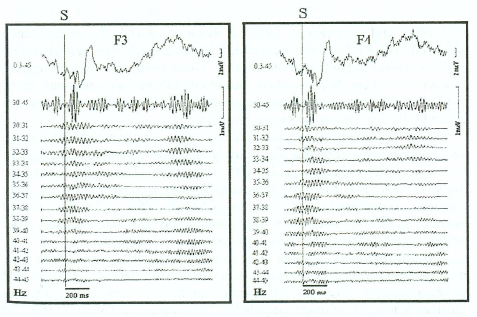
Figure 1. The wide and narrow band frequency filtering of ERP at F3 and F4 electrodes in the range of gamma activity between 30 and 45 Hz. The wide frequency filtering is under ERP. Below - the same ERP after narrow band filtering with the step in 1 Hz between 30 and 45 Hz
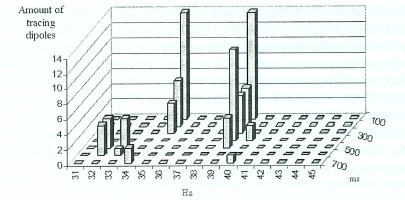
Figure 2. The time-frequency histogram of evoked activity of frequency selective gamma generators. Axis X - frequency scale with the step in 1 Hz between 30-45 Hz. Axis Y - time scale with time window of 100 ms. Axis Z - activity in each gamma generator estimated by the amount of equivalent dipoles in the whole brain volume.
It has found the frequency and time discreteness in the activity frequency-selective gamma generators. The activity of gamma generators at neighbor frequencies does not coincide with each other. They can be excited independently. This future of gamma generators is presented on the time-frequency histogram for time window of ERP 0-700 ms after the stimulus onset (Fig. 2). This data show that gamma generators are probably finer tuning at certain frequency than it has been assumed before.
Localization of tracing dipole for frequency-selective gamma generators over structural MRI slices revealed their spatial discreteness - point binding to brain structures that was depended on attention to stimuli. Fig. 3 shows changes in location of tracing dipole for gamma generator working at 35 Hz under the influence of active attention. The equivalent dipoles of gamma generators during passive attention were found at interval of sensory response mainly in auditory cortex. During active attention (performance of sensory-motor reaction to the same stimuli) dipole sources were located in anterior cingulate and or prefrontal areas as well as in the auditory cortex. The top-down processes in cingulate and prefrontal cortex change the sensory response of evoked gamma activity in modal specific auditory cortex.
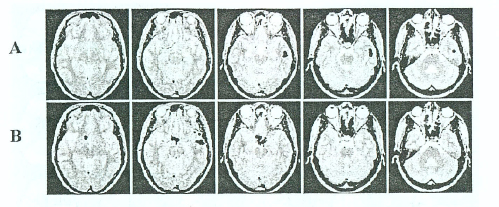
Figure 3. The projections of equivalent dipole sources are shown over axial slices received by structural MRI during sensory response (0-100 ms after stimulus onset) for a single subject. Dipole sources for gamma generator oscillating at 35 Hz during passive attention are found in a local zone in the auditory specific area of right temporal lobe. This activity zone is vertically oriented. Dipole sources of the gamma generators working at the same frequency during the reaction task performance are obtained in two local zones: in the modal specific cortex as well as in the medial prefrontal cortex.
Relationships between gamma generators that are parallel activated in prefrontal and auditory cortex under active attention to auditory stimuli are characterized by cyclic exchanging of their dipole sources. Fig. 4A, В shows projections tracing dipoles of gamma generators at the 35 Hz frequency over slices taken from atlas. The numbers show the time when dipoles appear after stimulus. The isolines over six paired axial slices represent different value of dipole coefficient and reflect reliability degree of dipole locations. A - Localization of tracing dipoles during sensory response in the condition of passive attention to auditory stimuli. Whole dipoles are located in modal-specific auditory cortex. В - The circulation in gamma activity between prefrontal and auditory cortex. At the beginning of sensory response (100 ms after stimulus onset) focus of gamma activity appear in a local zone of prefrontal cortex. Then it is displaced to a local area in auditory cortex and returned back to the prefrontal cortex. This cycle is repeated four times during 100 ms after the stimulus. The duration of each cycle is about 15 msec. In the picture two cycles are shown. In other words we see the signal reverberation in two brain areas that presented by gamma generators oscillating at the same frequency with identical phase-locking to sound stimuli. In the condition of active attention the prefrontal cortex plays the leading role in this binding top-down and bottom-up processes and the integration of brain areas in a system is periodic process.
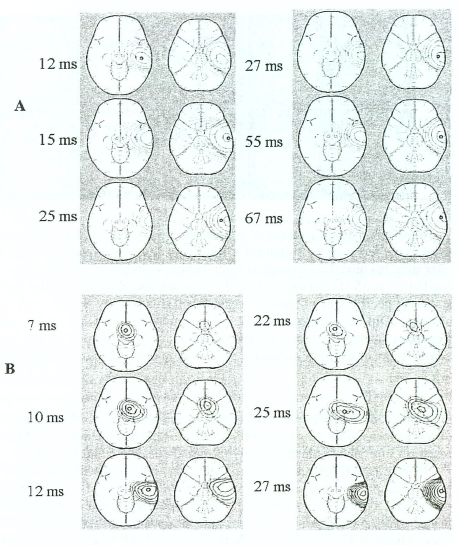
Figure 4A, B. The circulation in gamma activity at frequency 35 Hz has appeared between prefrontal and auditory cortex during sensory response in the condition of active attention to auditory stimuli that has reduced under passive attention to stimuli.
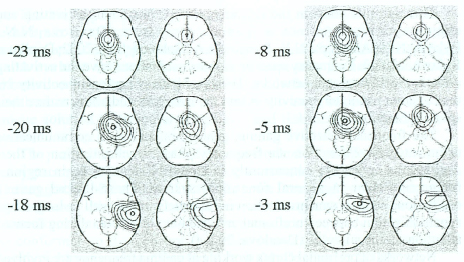
Figure 5. The similarity of the gamma activity during anticipation reaction and sensory response in the condition of active attention to auditory stimuli.
The anticipation reaction is formed under regular stimulus presentation with constant intervals. This reaction appeared in the time window from 200 to 0 ms before stimulus onset at the same frequencies as a sensory evoked response. This reaction is similar to the sensory response by brain location and cyclic character in activity of dipole sources (Fig. 5).
Discussion
The data presented demonstrate that there exist distributed systems of gamma generators tuning at different frequencies that become excited independently, confirming the frequency specificity of local neuronal networks. This statement is in agreement with the working hypothesis that gamma rhythm exists as a diffuse, distributed and parallel processing system (Basar, E., Basar-Eroglu, C, Karakas, S., Schurman, M., 2001). The gamma rhythm is presented as a total activity of many frequency-selective gamma generators and gamma activity is characterized by time and frequency discreteness.
These results confirm the earlier received data about activating and communicative functions of gamma generators (Danilova, N.N., Bykova, N.B., Anisimov, N.V., Pirogov, Y.A., Sokolov, E.N., 2002; Danilova, Bykova, 2003a). Frequency specific gamma oscillations have the activating effect on local neuronal networks. They facilitate synaptic connectivity via the coherent oscillatory activity within the networks and allow realize their specific functions.
The frequency-selective gamma generators perform a communicative or an integrative function via frequency-phase synchronisation of their oscillations appearing concurrently in spatially separate brain regions, integrating their in general functional system. Phase-locked gamma oscillations support synchronization in local network as well as long-range synchronization between prefrontal and another cortex area during focused attention on the stimulus (Danilova, 2006a).
Networks of prefrontal cortex working at gamma frequency are involved in informational processes that distinguish active attention from passive attention. Circulations of narrow band gamma activity between prefrontal and modal specific auditory cortex characterize processes of active, voluntary attention. The top-down processes in prefrontal cortex modulate the sensory response of evoked gamma activity in modal specific cortex. Anticipation reaction formed in the condition where stimuli were presented with constant intervals is similar to the sensory response. The patterns of dipole localizations show a high similarity during both perception (100 ms after stimulus) and anticipation of auditory stimulus (100 ms before stimulus onset). The anticipation reaction reproduces reverberation of gamma activity at the same selective frequencies as a sensory evoked response of gamma rhythm.
Our finding received by the method of microstructure analysis of gamma rhythm suggest the idea of many investigators that the phase-synchronization of oscillatory activity is universal mechanism for communication between neuron networks, which provide cognitive processes (Basar, E., 1999; Klimesch, W., Sauseng, P., Hanslmayr, S, 2007).
The obtained results are compatible with the pacemaker hypothesis. The retention of gamma oscillations after average of single responses is evidence of the reset mechanism supporting phase-locked synchronisation of pacemaker rhythmical activity with stimulus (Pedroarena, Ch., Llinas, R., 1997). The synchronisation received at discrete gamma frequencies show that pacemaker wave reset exists in separate pacemaker neurons having oscillatory activity at different frequency.
The binding of gamma generators working at discrete frequencies to local brain zones are compatible with principles of separate pacemaker neurones and is not support the assembly hypothesis of gamma-rhythm origin.
A cycle in the activity of dipole sources may be considered as an information quantum allowing the exchange of information among the linked members in a phase-locked manner. This cyclic mode of operation may be a unique solution to temporary segregate and link neuronal assemblies to perform various cognitive operations.
The pacemaker hypothesis of gamma-rhythm origin allows assume that many pacemaker neurons exist into local networks of the brain structures. The integration of distant local networks in the functional systems is executed by frequency-phase synchronisation of endogenous activity in their pacemaker neurons that have common resonance frequency. This idea will be conformed to the concept that considers cognitive processes as the distributed brain systems (Posner, M.I., 2004; Duncan, J., 2004).
Our experimental data suggest the validity of the noninvasive method for distinguishing the local neuronal networks in human brain according to parameters of their frequency characteristics.
References
Basar, E. Brain function and oscillations. II: Integrative brain function // Neurophysiology and cognitive processes. Springer, 1999.476 p.
Basar, E., Basar-Eroglu, C, Karakas, S., Schurman, M. Brain oscillation in perception and mamory // International Journal of Psychophysiology. 2000. N 35. P. 95.
Basar, E., Basar-Eroglu, C, Karakas, S., Schurman, M. Gamma, alpha, delta, and theta oscillations govern cognitive processes // International Journal of Psychophysiology. 2001. N 39. P. 241-248.
Grechenko, T.N. Psychophysiology. Moscow: Gardariki, 1999. 358 p.
Danilova, N.N. Gamma-oscillations in human cognitive activity // XXX Russian conference on the problem of high nervous activity devoted to 150 Anniversary of I. Pavlov. SPb., 2000. P. 63-66. (Russian Edition).
Danilova, N.N., Bykova, N.B., Anisimov, N.V., Pirogov, Y.A., Sokolov, E.N. Gamma-rhythm of human brain electric activity in sensory coding // Biomedical radio electronics. 2002. N 3. P. 34-42. (Russian Edition).
Danilova, N.N., Bykova, N.B. Role of frequency specific codes in attention processes // Proceedings of II International Conference devoted to A.R. Luria 100 Anniversary "A.R. Luria and Psychology of XXI century". Moscow, 2003a. P. 290-295. (Russian Edition).
Danilova, N.N., Bykova, N.B. Oscillator activity of brain and information processes // Psychology: current trends of interdisciplinary research. Conference proceedings. Moscow, 2003b. P. 271-283. (Russian Edition).
Danilova, N.N. Frequency specificity of gamma-rhythm oscillations // Russian Psychological Journal, 2006 a. Vol. 3. N 2. P. 32-55. (Russian Edition).
Danilova, N.N. The role of high-frequency electrical brain activity in the realization of psychological processes // Psychology the Journal of the Higher School of Economics. 2006b. Vol. 3. N 2. P. 62-72.
Duncan, J. Selective attention in distributed brain system // Cognitive Neuroscience of attention (edited by M. Posner). NY; London: The Uilford Press, 2004. P. 105-113.
Eckhorn, R., Reitboeck, H.J., Arndt, M., Dickt, P. Feature linking via synchronization among distributed assemblies: Simulations of results from cat visual cortex//Neural Computation. 1990. N 2. P. 293.
Lutzenberger, W., Pulvermuller, F, Birbaumer, N. Words and pseudowords elicit distinct patterns of 30-Hz activity in humans // Neurosci. Lett. 1994.176, 115.
Pedroarena, Ch., Llinas, R. Dendritic calcium conductances generate high-frequency oscillation in thalamocortical neurons//PNAS. 1997. Vol. 94. P. 724728.
Klimesch, W, Sauseng, P., Hanslmayr, S. EEG oscillations: the inhibition-time hypothesis // Brain research reviews. 2007. 53. P. 63-88.
Posner, M.I. Progress in Attention Research // Cognitive Neuroscience of attention (edited by M. Posner). NY; London: The Uilford Press, 2004. P. 3-9.
Pulvermuller, F, Preissl, H., Lutzenberger, W, Birbaumer, N. Spectral responses in the gamma-band: physiological signs of higher cognitive processes? //NeuroReport. 1995. N 6. P. 2057.
Singer, W. Response synchronization of cortical neurons: an epiphenomenon or a solution to the binding problem? // Ibro News. 1991. V. 19. N 1. P. 6.
Singer, W., Gray, CM. Visual feature integration and the temporal correlation hypothesis // Annu. Rev. Neurosci. 1995. 18. P. 555-586.
Tallon-Baudry, C, Bertrand, O., Bouchet, P., Pernier, J. Gamma-range activity evoked by coherent visual stimuli in humans // Eur. J. Neurosci. 1995. P. 7. P. 1285-1291.
Tallon-Baudry, C, Kreiter, A., Bertrand, O. Sustained and Transient Oscillatory Responses in the Gamma-Band and Beta-Band in a Visual Short-Term-Memory Task in Humans // Visual Neuroscience. 1999. Vol. 16. Iss. 3. P. 449-459.
Note
[1] This work is supported by RFHR, grant 07-06-0042la (Russia).
To cite this article: Danilova, Nina N. (2008). Frequency-Selective Gamma Generators in Processing of Auditory Stimuli. Psychology in Russia: State of the Art, 1, 299-308
The journal content is licensed with CC BY-NC “Attribution-NonCommercial” Creative Commons license.









